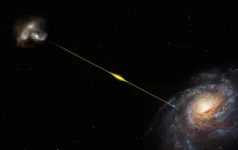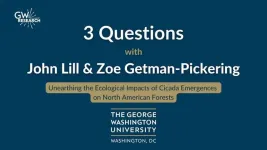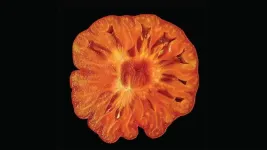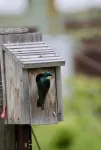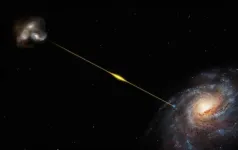(Press-News.org) Dementia experts from UC San Francisco will join their peers from around the globe at the annual Clinical Trials on Alzheimer’s Disease (CTAD) conference in Boston from Oct. 24 to 27.
Presentations cover breakthroughs in therapies that clear amyloid – a hallmark of Alzheimer’s – and a symposium on patients with early Alzheimer’s symptoms who were treated with the anti-amyloid medication donanemab, which may be approved by the end of the year. Other topics include novel treatments, diagnostic blood biomarkers, amyloid-related imaging abnormalities (ARIA) and Medicare coverage.
This year’s keynotes will address disease modifying treatments, how to develop more equitable and valid trials, emerging therapies, Alzheimer’s prevention studies, and ARIA in mice and its implications in people.
CTAD brings together leaders from academic research centers, patient advocacy groups, international research coalitions and pharmaceutical companies.
UCSF presentations include the following:
• Charles Windon, MD, will present Race and Sex Effects on Rates of Amyloid-Positivity in Real-World Memory Care. Using data from 17,000 participants enrolled in the IDEAS study, Windon and colleagues looked at PET scans in female and African American, Latino and Asian individuals, to evaluate ethnocultural and sex differences in amyloid rates. The presentation is part of a symposium starting at 4:55 p.m. EDT on Tuesday, Oct. 24. Windon will be joined by Gil Rabinovici, MD, senior author of the study.
• Renaud La Joie, PhD, will present Quantitative Amyloid-PET in Real-World Practice. Amyloid PET scans are required to ensure that patients who have or may be developing symptoms of dementia are candidates for anti-amyloid therapies like lecanemab (Leqembi). In this study, La Joie and colleagues quantified amyloid deposits from more than 10,000 PET scans taken from clinical settings in the IDEAS study, rather than academic settings, which follow strict protocols, to see if readings were consistent with the scans. The presentation takes place at 11 a.m. EDT on Friday, Oct. 27. La Joie will be joined by Gil Rabinovici, MD, senior author of the study.
• Rachel Nosheny, PhD, will present Establishing the Validity of a Novel Electronic Clinical Dementia Rating. Many older adults who have cognitive impairment, or who are at risk of getting it, go undiagnosed. Nosheny and colleagues tested the validity of an electronic version of the Clinical Dementia Rating (CDR), which screens for and determines the stages of dementia. The eCDR can be self-administered. The presentation takes place at 11:30 a.m. EDT on Friday, Oct. 27. Nosheny will be joined by Yan Li, PhD, of Washington University, St. Louis, senior author of the study.
• Also present will be Adam Boxer, MD, PhD, principal investigator and project leader of the Alzheimer’s Tau Platform trial, which received a $151 million grant from the National Institute on Aging. The trial will combine an anti-amyloid therapy with tau therapies, the first of its kind for late-onset Alzheimer’s, the most common form of dementia.
About UCSF Health: UCSF Health is recognized worldwide for its innovative patient care, reflecting the latest medical knowledge, advanced technologies and pioneering research. It includes the flagship UCSF Medical Center, which is a top-ranked specialty hospital, as well as UCSF Benioff Children’s Hospitals, with campuses in San Francisco and Oakland; Langley Porter Psychiatric Hospital; UCSF Benioff Children’s Physicians; and the UCSF Faculty Practice. These hospitals serve as the academic medical center of the University of California, San Francisco, which is world-renowned for its graduate-level health sciences education and biomedical research. UCSF Health has affiliations with hospitals and health organizations throughout the Bay Area. Visit https://www.ucsfhealth.org/. Follow UCSF Health on Facebook or on Twitter
###
Follow UCSF
ucsf.edu | Facebook.com/ucsf | Twitter.com/ucsf | YouTube.com/ucsf
END
Neuroscientists to reveal new insights into Alzheimer’s
2023-10-19
ELSE PRESS RELEASES FROM THIS DATE:
New study finds racial and ethnic disparities persist in access to chiropractic care and physical rehabilitation for adults with low back pain
2023-10-19
BOSTON - Low back pain is the leading cause of disability worldwide and a major driver of healthcare costs in the United States, according to the World Health Organization. Over the last 20 years, recommended treatment of low back pain has shifted from use of pain medications including opioids to early use of nonpharmacologic treatments such as spinal manipulation and therapeutic exercise which are commonly provided by chiropractors and physical therapists. However, while nearly all Americans will experience back pain at some point in their lives, most Americans ...
Record-breaking fast radio burst offers path to weigh the Universe
2023-10-19
In a paper published today in Science, a global team led by Macquarie University’s Dr Stuart Ryder and Swinburne University of Technology’s Associate Professor Ryan Shannon, report on their discovery of the most ancient and distant fast radio burst located to date, about eight billion years old.
The discovery smashes the team’s previous record by 50 per cent. It confirms that fast radio bursts (FRBs) can be used to measure the “missing” matter between galaxies.
The source of the burst was shown to be a group of two or three galaxies that are ...
Unearthing the ecological impacts of cicada emergences on North American forests
2023-10-19
WASHINGTON (October 19, 2023) – Every 13 or 17 years, billions of cicadas emerge from the ground to reproduce in eastern North American deciduous forests. One of the largest emergence events of these insects happened in 2021 when theBrood X cicadas emerged. Researchers who studied that once-in-a-generation event are now unveiling the impact this occurrence had on forest ecosystems, specifically on birds, caterpillars and trees.
In a new study published today in Science, researchers at the George Washington University, Georgetown University and the University of Maryland quantified the widespread ...
Agricultural landscapes and heat erode nest successes of birds across the United States
2023-10-19
Maximum temperature extremes reduce the nesting success of birds across the United States by nearly 50% in agricultural landscapes but not forests, according to a new study based on more than 20 years of citizen-science nest-monitoring data. The findings show that future warming may exacerbate the negative effects of habitat conversion on bird fitness, especially among species of conservation concern in human-dominated landscapes. Habitat conversion and climate change are fundamental drivers of biodiversity loss worldwide. However, ...
Observations from a bright fast radio burst probe the distant universe
2023-10-19
An unusually high-energy fast radio burst (FRB) from a high-redshift galaxy has offered new insights into the distant universe, challenging current models of FRB emission. The findings also help constrain key attributes of these astrophysical phenomena. FRBs are brief pulses of radio emission originating from distant extragalactic sources. Although the astrophysical processes that cause FRBs aren’t fully understood, the signals they produce can be used to infer information about the cosmic environments they pass through as they travel across the universe, including the nature of ...
Introducing NorthPole: a brain-inspired chip design that enables low-power AI inference
2023-10-19
Researchers present NorthPole – a brain-inspired chip architecture that blends computation with memory to process data efficiently at low-energy costs. Since its inception, computing has been processor-centric, with memory separated from compute. However, shuttling large amounts of data between memory and compute comes at a high price in terms of both energy consumption and processing bandwidth and speed. This is particularly evident in the case of emerging and advanced real-time artificial intelligence (AI) applications like facial recognition, object detection, and ...
Periodical cicada emergence disrupts food webs, increases plant damage in eastern North American forests
2023-10-19
The periodical mass emergence of cicadas in eastern North American forests can “rewire” forest food webs and initiate a cascade of ecological impacts that propagates throughout the food chain, according to a study that quantified effects of the 2021 Brood X cicada emergence. The study found that when insect-eating birds have abundant prey in the form of cicadas and thus shift their focus away from their usual repast – leaf-eating caterpillars – the caterpillars feast more heavily upon the leaves of oak saplings, doubling insect leaf damage. “Although previous studies have documented strong ecological ...
You say genome editing, I say natural mutation
2023-10-19
For tens of thousands of years, evolution shaped tomatoes through natural mutations. Then, humans came along. For centuries, we’ve bred and cherry-picked tomatoes with our preferred traits. Today, CRISPR genome editing allows us to make new crop mutations that improve traits even further. However, individual mutations, whether natural or engineered, don’t work alone. Each operates in a sea of thousands of so-called “background” mutations. These changes have been sowed by evolution and agricultural ...
Heat waves harm bird reproduction on agricultural lands
2023-10-19
Bird populations are in rapid decline across North America. While climate change is just one of the many factors influencing North American birds, its effects are significant and can interact with other stressors, such as habitat loss. A team of University of California, Davis, researchers found that the effects of extreme temperatures on avian reproduction can vary depending on the type of environment that birds call home.
The findings, published in the journal Science, shed light on how climate change can combine with habitat loss to affect bird reproduction ...
Astronomers detect most distant fast radio burst to date
2023-10-19
An international team has spotted a remote blast of cosmic radio waves lasting less than a millisecond. This 'fast radio burst' (FRB) is the most distant ever detected. Its source was pinned down by the European Southern Observatory’s (ESO) Very Large Telescope (VLT) in a galaxy so far away that its light took eight billion years to reach us. The FRB is also one of the most energetic ever observed; in a tiny fraction of a second it released the equivalent of our Sun’s total emission over 30 years.
The discovery of the burst, named FRB 20220610A, was made in June last year by the ASKAP radio telescope in Australia ...
